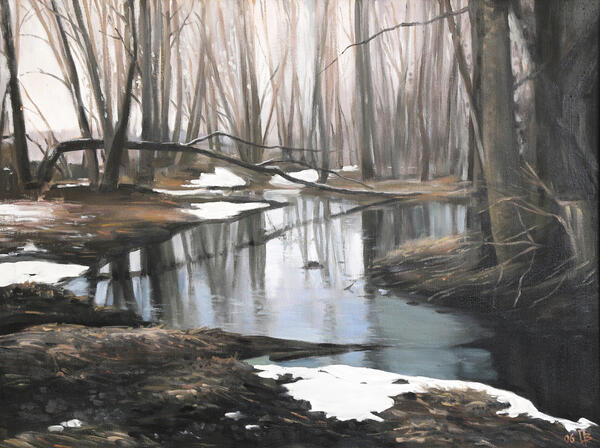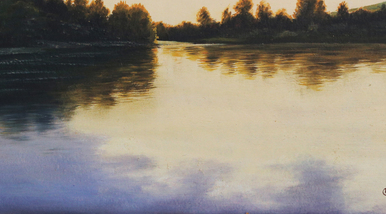Valentin Pavlovich Pavlov, the painter of The Chaos of Spring, is a talented artist and poet from Novokuznetsk, in Kemerovo region. He started painting in 1949, and specialized in landscapes. Valentin Pavlov’s first solo exhibition was held in 1995. In 2005 he published his own art book: Paintings. Drawings. Verses. All his life Valentin Pavlov was involved in various social projects, and was a member of the Novokuznetsk department of the National Society for the Protection of Monuments of Culture and History.
The main subject in his art was the beauty of his native region, in which he was fully immersed and depicted with respect, and great accuracy. Sometimes the artist drew on his imagination, as if aware that his brush was unable to portray what he wanted to express. Under the surface of its realism, each of Valentin Pavlov’s works
hides a philosophical meaning, with secrets and enigmas. His painting involves the viewer in a mental dialogue with the painter, filling them with a sense of love for the natural world.
The Chaos of Spring depicts the mysterious reawakening of nature in the Mountain Shoria region, after its winter hibernation.
In the foreground we see the earth covered with a carpet of last autumn’s dry leaves. The white snow forms a vivid contrast with the richly-textured earth. The ochres and browns of the melting snow contrast with the somber, muted tones of the background, giving the painting visual depth and atmosphere. In the center of the painting, the glassy surface of the water reflects the branches of the trees, with their complex tracery. In the distance, we see the forest, illuminated by the bright rays of the sun, which have forced their way between the tree trunks.
In this picture we feel spring everywhere — in the interwoven trees, the melting snow, and in the air itself. The painting’s name, The Chaos of Spring, eloquently expresses the state of the natural world at this time of the year, when the weather changes from sunny to overcast at a moment’s notice and rain alternates with the last snowfalls of winter.
The region depicted in this painting has long been inhabited by the Shorians, or Kuznetsk Tatars. The local people believed that in spring, when the snow begins to melt and the buds appear on the trees, the good spirits return to the earth after their long absence. At this time of year the shaman used to pray to the mountain spirit Tag-Eezi for the prosperity of his people. The people made sacrifices to the lord of the mountains.
In the past, the Shorian people considered that the year began with the arrival of spring. Traditionally, they celebrate the festival of Chyl-Pazhi, which literally means “head of the year”, on the day of the Spring equinox. On that day they performed rituals to see out the old year and meet the rising Sun. It was said that the first person to see the rays of the sun on the day of the spring equinox would enjoy a “double measure of happiness”.
In this painting Valentin Pavlov vividly conveys the solemnity of nature’s awakening from hibernation. The picture radiates a clear harmony, which the artist shares with the viewer.
The main subject in his art was the beauty of his native region, in which he was fully immersed and depicted with respect, and great accuracy. Sometimes the artist drew on his imagination, as if aware that his brush was unable to portray what he wanted to express. Under the surface of its realism, each of Valentin Pavlov’s works
hides a philosophical meaning, with secrets and enigmas. His painting involves the viewer in a mental dialogue with the painter, filling them with a sense of love for the natural world.
The Chaos of Spring depicts the mysterious reawakening of nature in the Mountain Shoria region, after its winter hibernation.
In the foreground we see the earth covered with a carpet of last autumn’s dry leaves. The white snow forms a vivid contrast with the richly-textured earth. The ochres and browns of the melting snow contrast with the somber, muted tones of the background, giving the painting visual depth and atmosphere. In the center of the painting, the glassy surface of the water reflects the branches of the trees, with their complex tracery. In the distance, we see the forest, illuminated by the bright rays of the sun, which have forced their way between the tree trunks.
In this picture we feel spring everywhere — in the interwoven trees, the melting snow, and in the air itself. The painting’s name, The Chaos of Spring, eloquently expresses the state of the natural world at this time of the year, when the weather changes from sunny to overcast at a moment’s notice and rain alternates with the last snowfalls of winter.
The region depicted in this painting has long been inhabited by the Shorians, or Kuznetsk Tatars. The local people believed that in spring, when the snow begins to melt and the buds appear on the trees, the good spirits return to the earth after their long absence. At this time of year the shaman used to pray to the mountain spirit Tag-Eezi for the prosperity of his people. The people made sacrifices to the lord of the mountains.
In the past, the Shorian people considered that the year began with the arrival of spring. Traditionally, they celebrate the festival of Chyl-Pazhi, which literally means “head of the year”, on the day of the Spring equinox. On that day they performed rituals to see out the old year and meet the rising Sun. It was said that the first person to see the rays of the sun on the day of the spring equinox would enjoy a “double measure of happiness”.
In this painting Valentin Pavlov vividly conveys the solemnity of nature’s awakening from hibernation. The picture radiates a clear harmony, which the artist shares with the viewer.



